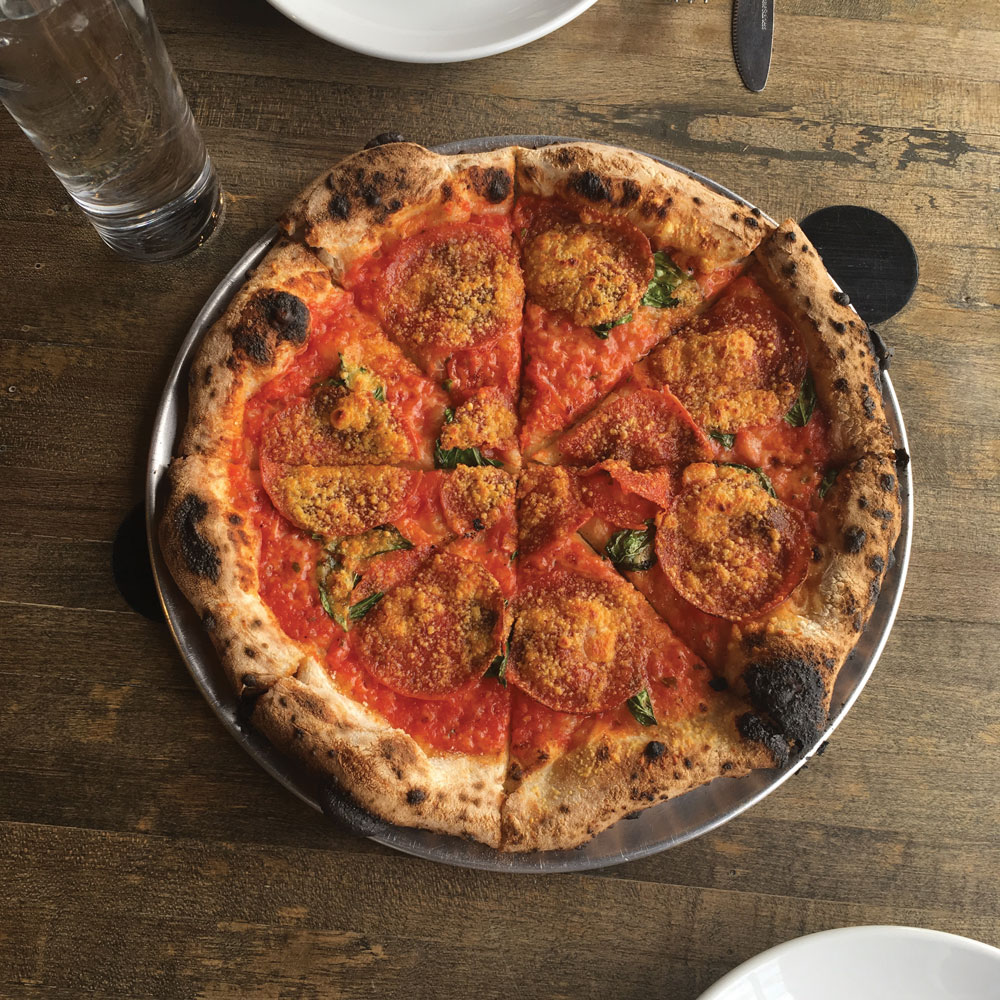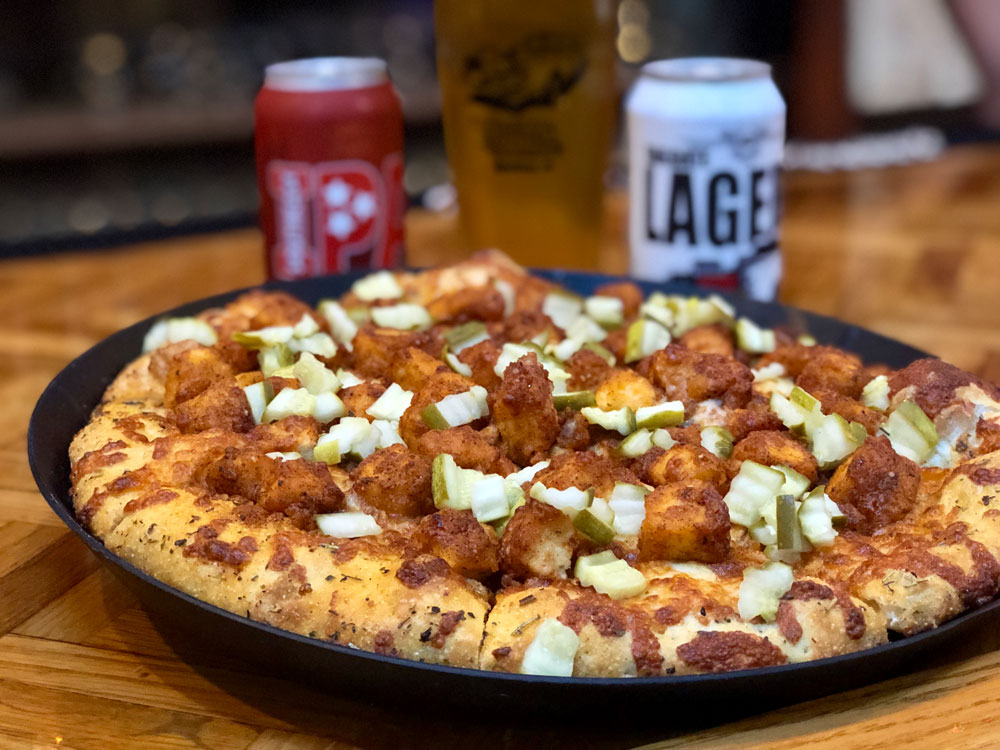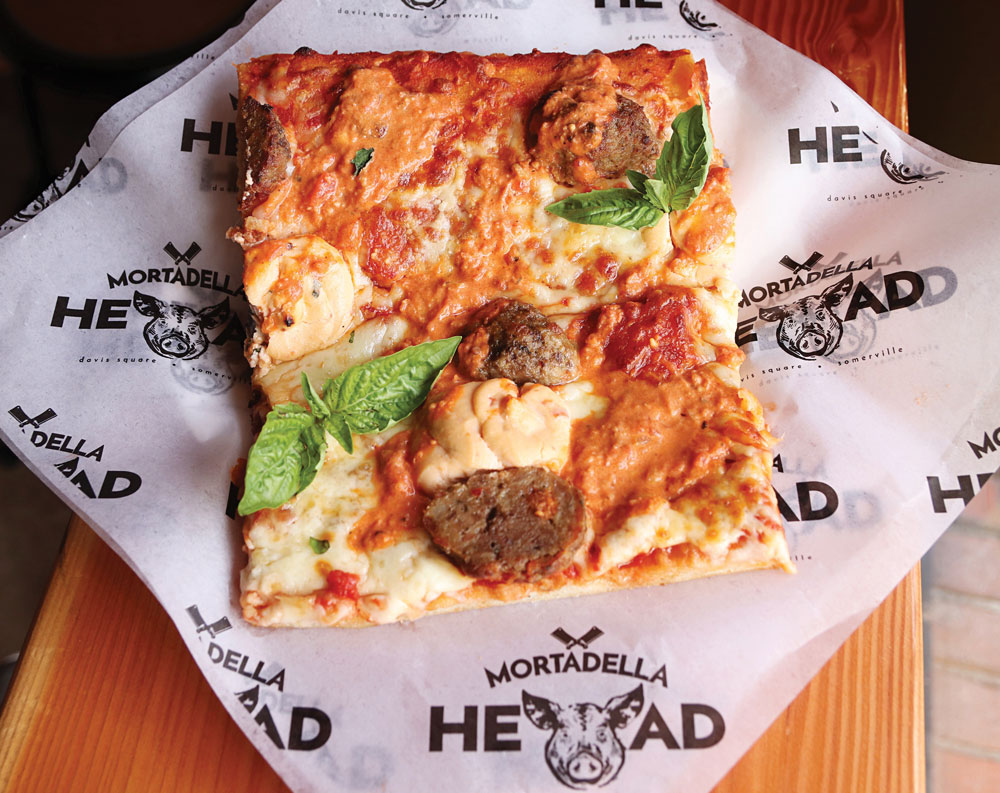Experts agree: Sauce can make a pizza sing. That simple layer of liquid atop your crust helps make even plain cheese pies stand out—or, when combined with the perfect complementary toppings, can create a truly memorable specialty pie experience for your customers. From crafting the perfect red sauce to thinking outside the box with adventurous and unexpected alternatives, operators across the country are certainly stirring the pot. Here, we explore the stories behind some of their most successful creations.
Top Tomato
Red sauce—can any pizzeria live without it? But a great base can consist of the simplest of components; in fact, many operators believe basics are best, staying true to taste with only a few select ingredients. “Our fresh-made marinara that goes onto standard pies is made with care to be complementary, but not overwhelming, to the dough and toppings,” notes Wesley Keegan, owner and brew master, who developed the gourmet pizza menu at his three TailGate Brewery outposts in Nashville, Tennessee. “Our house tomato sauce is simply crushed tomatoes, tomato sauce, a touch of Italian seasoning and salt. Sauce needs to be simple, and a good sauce can make an otherwise OK pizza a great pizza. Those bright flavors should come through the cheese and toppings.”
Josh Jacobsen, executive chef at Peel Handcrafted Pizza, a Neapolitan-inspired restaurant in Frederick, Colorado, with a forthcoming second location in Loveland, agrees that the ideal tomato sauce should be designed to balance out a pizza—not overpower it. “A heavy or too-spicy sauce can be too much,” he says. And Chuck Sillari, co-founder (with Sebastian Fricia) of Mortadella Head in Somerville, Massachusetts, believes chefs can’t go wrong with a simple recipe, such as ripe, hand-crushed San Marzano or California tomatoes with a drizzle of olive oil and a sprinkle of grated Pecorino cheese.
 |
|
Peel Handcrafted Pizza crafts its tomato sauce with simple ingredients to complement, not overwhelm, its Neapolitan-style pies like the Pepperoni Rustica. Photo courtesy Peel Handcrafted Pizza. |
Monthly Dish-spiration
The team at TailGate Brewery isn’t afraid to think outside the box with sauce bases like nacho cheese (perfect for mac-and-cheese and taco pizzas), ranch dressing and even gravy, used for its Thanksgiving-themed pizza of the month last November. Meanwhile, in December, the pizza of the month was the Nashville Hop Chicken, which ditched a traditional sauce base and instead pulled flavor from the crispy chicken’s sauce: butter blended with cayenne, garlic, black pepper, sugar, salt, paprika and Styrian Golding hops to emulate Nashville’s famed hot chicken.
“The way we determine the sauces to use—especially when we’re doing a departure from normal tomato sauce—is by being inspired by classic dishes and turning them into pizza: Reuben sandwiches, Thanksgiving dinner, lasagna, tacos and, most recently, Nashville hot chicken,” Keegan explains. “TailGate favorites include sauces like pesto, ranch and nacho cheese, and our ever-changing pizza of the month allows us to get really out-there with sauces, using things like Russian dressing and turkey gravy. If it spreads, we’ll put it on a pizza!” When crafting those exotic pizzas of the month, chefs appreciate the freedom to run a bit wild—while less adventurous customers can remain firmly in their comfort zones with the more traditional favorites on the main menu.
 |
|
The Nashville Hop Chicken at TailGate Brewery forgoes traditional marinara and instead pulls flavor from the crispy chicken’s spicy, hop-infused sauce. Photo courtesy TailGate Brewery. |
Creative Culture
| Good Measure |
| You have the perfect sauce—but can pizza makers add too much of a good thing? When seeking the proper sauce portion, operators agree that striking the right balance often comes down to the crust:
“Personally, every time I go out for pizza, I ask for extra sauce—pizza is one of those foods where excess is a good thing! For TailGate’s pizza, it would be easy to say, ‘put on a lot,’ but we needed to find the right balance to fit our dough, which you could describe as artisan or craft. Our dough is basic in terms of feel, but the texture and flavor combines sweet, salty and buttery. The baked result is fluffy with just a little heft, so it’s easy to pull apart. We want customers to enjoy all of the layers of flavors, right through to the sauce and toppings.” —Wesley Keegan, owner and brew master, TailGate Brewery, Nashville, TN “The amount of sauce depends on the type of crust. The thinner the crust, the lighter you go with the sauce. That’s why our Roman-style pizza al taglio gets a heavy dose of sauce, to balance out the sturdy and crispy crust.” —Chuck Sillari, co-founder, Mortadella Head, Somerville, MA “We specialize in Neapolitan-style, so it’s all about balance throughout the pizza. In determining the amount of sauce, you must also consider the intensity and structure of the sauce. Typically, we sauce about three ounces for most of our pizzas if we want it to have a similar consistency to a classic red sauce. For oil-based or runny-style sauces, we go considerably lighter.” —Josh Jacobsen, executive chef, Peel Handcrafted Pizza, Frederick, CO |
At Denver-based Parry’s Pizzeria & Bar, sauce experimentation is a year-round delight—but can come into even sharper focus when tied with specially themed events and promotions. For example, when the pizzeria hosted its first-ever Dogfish Head Tap Takeover last October, memorable dishes were made to match, including Shrimp Scampi Pizza with an Alfredo sauce base, and Poncho Pizza (a take on the taco) with a tomatillo and avocado base. “We asked our guests for feedback on the special menu, and they overwhelmingly loved these creative pizzas,” enthuses Vanessa Clark, vice president of marketing for Parry’s. “They even asked us to put them on the menu all the time, so we’re working on it!”
Clark adds that thinking fresh and local in terms of ingredients clearly sets the pizzeria apart, right down to its sauce selections. With roots in Colorado, the team makes a concentrated effort to incorporate that culture into its menu, experimenting with ingredients like green chilies, as well as looking to other regions—for example, by incorporating Buffalo-style hot sauce into dishes. “Some of our favorite pizzas are totally outside the box, like our New Mexican Yankee, with a green chili base, or The Pearl, a white pie using an oil base with ricotta cheese and sausage,” Clark says. “The key to finding the right sauce for our pies is to align the flavor profiles and not be afraid to create a totally new sauce that’s unexpected. Some pizzas are all about the sauce, and for others you don’t even want to notice it, so be intentional with your choices!”
 |
|
The pink vodka sauce on Mortadella Head’s ricotta and meatball pie can be cross-utilized by tossing with some pasta and fresh basil. Photo courtesy Mortadella Head. |
Mix and Match
| Spicy Gochujang Sauce |
Provided by Peel Handcrafted Pizza
Sauté the onions and garlic powder until the onions are translucent. Add the gochujang paste and mix. After the mixture comes to temperature, add the water. Add all remaining ingredients. Cook for 20 to 40 minutes on low heat. Remove from heat and blend until smooth. Season to taste. |
“Fresh-casual” franchise My Pie, based in Scottsdale, Arizona, doesn’t skimp on its sauce collection; after all, the concept requires perfect pairings with more than three dozen toppings. The seven options, made fresh in-house from signature recipes, were passed down from the owner’s grandmother, who loved unique pizza sauces—and, accordingly, they offer a flavor rainbow: Pizza Sauce, Spicy Fra Diavolo, Marinara, Alfredo Cream, Savory BBQ, Garlic and EVOO, and Pesto.
But the choices don’t end there. “We also encourage our customers to mix and match, such as jazzing up their Alfredo with extra garlic or doing half pizza sauce with a drizzle of pesto,” notes Ryan Mitchell, owner of My Pie. “Great sauces can really revolutionize the way a pizza lover thinks about pizza. They can help add pizzazz to standard toppings or mix up a new favorite. We also think it lends seasonality; for example, customers might want to eat lighter in the summer or enjoy a barbecue-flavored pie, while in the winter they may select something with a little heat. We truly think variations in sauce allow customers to enjoy more variety—and therefore eat pizza more often over the course of a week.”
Of course, once you’ve nailed the perfect sauce lineup, don’t forget to look for opportunities to cross-utilize them on other items, from appetizers to pastas. At Parry’s, chefs get creative by repurposing the green chili base used for the New Mexican Yankee pie. “It’s delicious on loaded fries as well as pizza,” Clark says. “We like to mix it up; the variety of flavors is fun and unexpected.” Similarly, Sillari likes to use pink vodka sauce both as a base for his meatball and ricotta pie, and tossed with some tagliatelle and fresh basil for a perfect pasta dish. The takeaway: Don’t simply experiment with sauce recipes; find various creative ways to use them across your menu!
Tracy Morin is PMQ’s senior copy editor.













